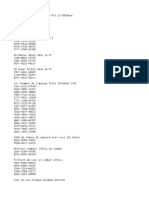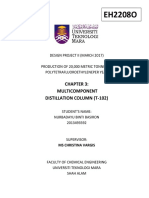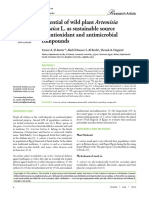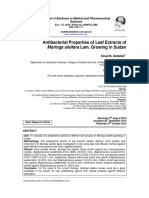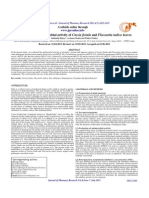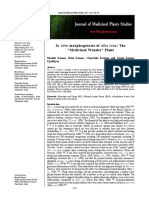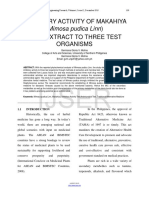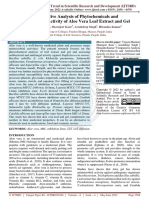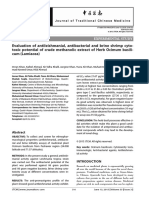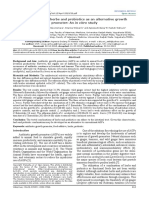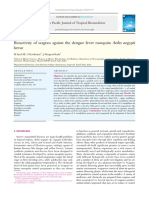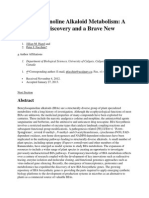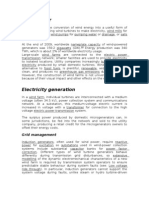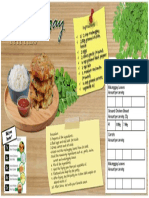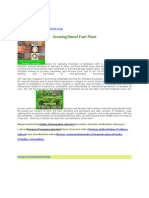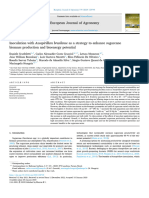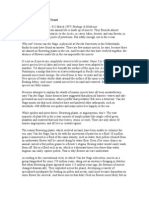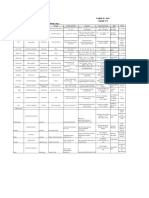Professional Documents
Culture Documents
Antifertility Effect of Aqueous and Alcoholic Extract of Momordica Dioica and Melia Azedarach On Male Albino Rats
Antifertility Effect of Aqueous and Alcoholic Extract of Momordica Dioica and Melia Azedarach On Male Albino Rats
Original Title
Copyright
Available Formats
Share this document
Did you find this document useful?
Is this content inappropriate?
Report this DocumentCopyright:
Available Formats
Antifertility Effect of Aqueous and Alcoholic Extract of Momordica Dioica and Melia Azedarach On Male Albino Rats
Antifertility Effect of Aqueous and Alcoholic Extract of Momordica Dioica and Melia Azedarach On Male Albino Rats
Copyright:
Available Formats
Volume 9, Issue 1, January 2024 International Journal of Innovative Science and Research Technology
ISSN No:-2456-2165
Antifertility Effect of Aqueous and Alcoholic
Extract of Momordica Dioica and
Melia Azedarach on Male Albino Rats
Richa Sharma1 and D.N.Choudhary2*
1
Research Scholar, 2Associate Professor
University Department of Zoology, TMBU, Bhagalpur, Bihar, India
Corresponding Author: D. N. Choudhary*
University Department of Zoology, TMBU, Bhagalpur, Bihar, India
Abstract:- Plants have long been utilized to treat a from ancient times[7]. Numerous expert have looked at the
variety of illnesses. Search for male antifertility factor of contraceptive qualities of hers and plant components in both
medicinal plants remained a potential area of men and women[8]. It has been noted that many
investigation. The present investigation was aimed to phytochemicals are becoming more significant in man [5].
study the effect of oral administration of two medicinal
plants , Melia azedarach (leaf) and Momordica In emerging nation, the population growth is one of the
dioica(fruit) at a dose of 100mg/kg body weight for 21 main causes of poverty and population. It is becoming a
days on reproductive organs of male albino rats. Body major problem i.e., facing a significant strain on economic,
weight, Reproductive Organ weight , Fructose content social and environmental resources. It is creating so many
in Coagulating gland(CG), Acid phosphatase activity in obstructions worldwide day by day[2][9]. With reference to
Ventral prostate(VP), Total protein in Seminal adjusting the human reproductive rate this overpopulation
vesicle(SV) were investigated in both control and treated can be controlled biologically[11]. Though different
groups. Histology of testis in treated rats showed hormonal contraceptive tablets are being developed
degenerative changes in the seminiferous tubules. The alongside, however, they all have negative effects, hence
decrease in sperm count with wider lumen, organ weight, there is an urgent need for an efficient plant based drugs to
fructose content in CG, protein content in SV, suggesting oppose these problems. In this context use of common
the antifertility activity in both tested plants. Corpus medicinal plants in reproduction meaning may be an
luteal sites, Implantation sites, and Litter size were also important tool to prevent population explosion[2][5].
found significantly reduced. Though anti spermatogenic activity of some medicinal
plants have been reported by many workers[3][7]. Few
Keywords:- Antifertility, Biochemical Parameters, Melia plants also possess male anti fertility activity[12][13].The
Azedarach, Momordicadioica, Sperm Count, Testis. present work has been carried out to study the antifertility
activity of two common medicinal plants i.e., Momordica
I. INTRODUCTION dioica(fruit) and Melia azedarach(leaf) on reproductive
organs of male albino rats. To know the contraceptive
Plants have historically been utilised to treat variety of strength of these two considered or selected medicinal plants
diseases. From time immemorial, humans have relied on rats were treated with both aqueous as well as alcholic
plants that could meet their basic necessities such as food, extract.
shelter, fuel and health[1][2].Plants have been used globally
across varied cultures as a safe natural source of medicines. II. MATERIAL AND METHOD
Search for male antifertility factor of medicinal plants A. Momordica dioica
remained a potential area of investigation[1][3][4]. For Momordica dioica, or spiny gourd, is a perennial
thousands of years Indian traditional medicine has been climber belongs to the Cucurbitaceae family. Traditional
performed through the use of Ayurveda. Many studies on the medical practitioners employ the fruit, leaves, and roots of
pharmacology and clinical therapies of Ayurvedic medicinal Momordica dioicaas medication. Plant extracts are thought
herbs have been conducted. It has been noted that many to provide antidiabetic[14], hepatoprotective[15],
phyto chemicals are becoming more significant in man[5]. renoprotective[16] and anti-hyperglycemic[17]properties.
In numerous animal model plants have been found to have Strong antioxidant properties have been observed for the
therapeutic and contraceptive properties[6].The practice of alcoholic extract of Momordica dioica. According to a
using contraceptive is not new. Contraceptive use has been study, the root of M. dioica extracted in ethanol has potent
expanded dramatically over last 40-50 years among women abortifacient properties[18]. The present study was
of all reproductive ages. Numerous plant and plant derived conducted to assess the antifertility activity of alcoholic and
items have been used as contraceptives and abortifacient aqueous extract of fruit of Momordica dioica.
IJISRT24JAN1361 www.ijisrt.com 1456
Volume 9, Issue 1, January 2024 International Journal of Innovative Science and Research Technology
ISSN No:-2456-2165
B. Melia Azedarach Male rats was sacrificed on 22nd day and different
The plant Melia azedarach Linn, or mahanimba, is a tissues were collected and weighed on Torsion balance.
member of the Meliaceae family[19]. It is a big, neem-like Serial sections of testis were prepared for microscopic
evergreen tree that grows all over India. It has historically observations [23].
been used as an astringent, stomachic, emmenagouge,
anthelmintic, and antilithic diuretic[20]. The study was Fructose estimation in Coagulating gland (CG) was
conducted to assess the antifertility activity of ethanolic and evaluated by colometry[24]. Acid phosphatase activity in
aqueous extract of leaf of Melia azedarach. Ventral prostate (VP) was evaluated by method adopted
Sigma Technical Bulletin no. 104[25]. Protein estimation in
C. Experimental Animal seminal fluid was estimated by colorimetry[26].
Male Sprague dawleyrats (170-200gm) body weight of
proven fertility were selected for the experiment. Three Spermatozoa collected from Caput, Corpus and Cauda
separate groups ( One for control and two for experimental) epididymis and vas were examined under compound
of male rats were selected . Each group containing 7 microscope and their number and morphology were
animals. The experimental group of rats were administered recorded [2][22].
orally with suspension of test plant extracts at a dose of
100mg /kg Body weight for 21 days .The control group was The data were analysed statistically using student t-
fed with distilled water for the same period of Test.
treatment[2][4].
III. RESULTS
D. Plant Extract Preparation
A. Body weight
Alcoholic Extract When Momordica dioica fruit extract (aqueous and
The plant extract was prepared by the method alcoholic) was administered orally, there was a significant
adopted[21]. Whole fruit ofMomordica dioicaand leaves of drop (P<0.01) in body weight when compared to the control
Melia azedarachwere taken for investigation. The fruit and group. Similarly, rats showed significant reduction (P< 0.01)
leafof the test plant were washed and dried at room in the body weight after oral administration of Melia
temperature . The dried plant parts were powdered by using azedarach( both aqueous and alcoholic) compared to
mixer grinder. 20gm of plant powder of each test plant was control( Table 1 and graph 1).The pituitary gland may be
poured into a conical flask containing 150ml of 50% of suppressed or has secreted less growth hormone (GH),
ethanol. The mixture was stirred, allowed to settled, and which would explain the cause of lower body
kept covered. At the end of second day the extract was weight[2][27][28].
filtered with no.1 what man filter paper. The filterate was
taken on a petri dish and evaporated at room temperature. B. Reproductive Organ Weight:
The residue remained in the petri dish was ready for There was a significant reduction in weight (P <0.01)
experiment. detected in the reproductive organs like Seminal vesicle
(SV), Coagulating gland (CG),Ventral prostate ( VP) Testis
Aqueous Extract and Epididymis(Table 1 and graph 2). Significant weight
Whole fruit of Momordica dioicaand leaf of loss of multiple reproductive organs in treated male rats may
Meliaazedarchwas taken. These parts was washed and air be due to decreased gonadotrophic activity or low androgen
dried. For extract preparation, 10g of dried plant parts will levels that interfere with spermatozoa formation and
be dissolved in100ml of distilled water and left for 12hrs maturation[29][30].
,filtered and diluted with distilled water for required
dose(0.1ml/rat/day). After 12 hrs the solution will be C. Biochemical Parameters
filtered. The filterate is now ready for dilution and required When compared to the control group, there was a
dose preparation[2][22]. significant decrease (P<0.01) in the biochemical parameters
such as Protein, Fructose, Acid Phosphatase activity
Fertility performance of individual rat was done from following the oral administration of both the test plants i.e.,
day 16th to 21st of treatment . Each male rat was caged Momordica dioica(fruit) and Melia azedarach(leaf)
separately with 2 coveal female of proven fertility. Presence (aqueous and alcoholic (Table 2 and Graph3). Decline in
of vaginal smear indicated that the females had mated to the fructose content in Coagulating gland (CG) and acid
particular male and the day of mating was considered to be phosphatase activity in Ventral prostate (VP) were possibly
the day 1st of pregnancy. due to decrease secretion of endogenous androgen [2][24].
Reduced protein content in SV of treated rats compared with
Laprotomy was done on 8th day of pregnancy to control group was due to toxic manifestation which lead to
examine the record of Corpora lutea and Implantayion sites. the breakdown of protein and impaired source of ATP
Litters was examined and litters size was recorded at production to meet the energy requirement [31].
term[3][23].
IJISRT24JAN1361 www.ijisrt.com 1457
Volume 9, Issue 1, January 2024 International Journal of Innovative Science and Research Technology
ISSN No:-2456-2165
D. Haematological Parameters IV. HISTOLOGY OF TESTIS
After the oral administration of Momordica
dioica(fruit) and Melia azedarach(leaf) (aqueous and A microscopic histological analysis of control group
alcoholic) though, there was reduction found in blood testes revealed normal germinal epithelium maturation and
glucose and haemoglobin level as compared to the control cytoarchitecture. Every stage of spermatogenesis ,including
group but it was not significant (Table 3 , Graph 5&6). primary and secondary spermatocytes and germinal
epithelium producing spermatogonia divided by sertoli cells,
E. Sperm Count is indicative of a healthy testis. Mature sperm ready for
Sperm count was also found significantly decreased ( release were visible in the lumen.
P< 0.001 and P< 0.05 ) in rats treated with both the plants
Momordica dioica(fruit) and Melia azedarach(leaf) Testes of rats treated with an aqueous and alcoholic
respectively compared to control group (Table 2 and Graph extract of Momordica dioica(fruit) showed sign of
4).The lowered sperm count in the treated male rats could be deteoriation of spermatogonial layer in the seminiferous
the consequence of disintegration of seminiferous tubule tubules and a decrease in the number of sperm in the lumen.
and leydig cell as well as decreased testosterone Though the tubules showing the trend of degeneration but it
synthesis[30][32]. It is commonly known that testosterone was not significant. Only one or two tubules were found
plays a critical role in spermatogenesis and affects the ruptured in the focus.Wider lumens were present with less
epididymal environment. It must have therefore affected spermatozoa and degeneration in spermatogonial layer were
spermatogenesis. Therefore, it was clear that alcoholic and observed(fig. 4&5).
aqueous extracts of both the test plants have antiandrogenic
property that may lead to antifertility in male The testes of rat treated with an alcoholic extract of
rats[27][30][33]. Melia azedarach(leaf) showed comparatively higher
degeneration in histology as well as number of sperms. The
F. Fertility performance test seminiferous tubules showed wider lumen and less
After oral administration of Momordica dioica(fruit) spermatozoa. Rupture in spermatogonial lining were also
extractMelia azedarach(leaf) extract(both alcoholic and observed under the microscope.The testis or rat treated with
aqueous ) a significant decrease (P<0.01) incorpus luteal aqueous extract of Melia azedarach though showed
sites, implantation sites and litter size, was observed ( Table spermatozoa in the lumen but there are certain
4and Graph 7 ). abnormalities(breakage) found in the spermatogonial lining.
Momordica dioica : Out of seven, Only five male rats Spermatozoa in the lumen were also found clumped in the
treated with an aqueous fruit extract of Momordica lumen of the tubule in comparison to testis of rats treated
dioica could be able to mate with only five normal with an alcoholic extract of Melia azedarach(fig.1&2).
female rats. In contrast, only three male rats out of seven
treated with alcohololic fruit extract of M. dioica were The reduced testicular weights and ruptured
able to mate with four normal female rats. seminiferous tubule with decreased tubular diameter
Meliaazedarach : Out of seven, only three male rats indicated wide spread damage[38].A reduction in the tubular
treated with an aqueous leaf extract of Melia azedarach diameter with less number of spermatozoa could be due to
could be able to mate with only three normal female rats a destructive effect of ethanolic extract of Momordica
whereas only four male rats out of the seven rats treated dioica(fruit)and Melia azedarach (leaf).Degeneration of
with alcoholic leaf extract of Meliaazedarcah were able seminiferous tubules and Leydig cells, less diameter of
to mate with only four normal female rats. tubular lumen with insufficient number of spermatozoa
could be due to insufficient production of androgen or
The decrease in implantation sites were obviously due antiandrogenic property of both the test
to changes in endocrine activity of luteal structures. Many plants[32][39].Seminiferous tubules with reduced or
plants have been reported to be anti-ovulatory and anti- ruptured spermatogenic components in both experimental
implantational[34]. However, the extracts showed groups suggested widespread injury to the testicular
abortifacient effects as there was reduction in viable litter structure. There were extremely few or no spermatozoa in
size. These abortifacient effects were indicative of either the lumen of some of the tubules. The testis's seminiferous
changes in maternal estrogen/progesterone ratio or may be tubular diameter (STD) shrank. In the testis of treated rats,
due to either inhibition of implantation or increased loosening and sloughing of the germinal epithelium were
resorption of fetuses[35]or due to some toxic components also noted[40].
reaching the female genital tract with semen[2][3]. In
addition , the number of decreased implantations may also
be due to the decreased sperm count and motility[37]may
be another important reason.
IJISRT24JAN1361 www.ijisrt.com 1458
Volume 9, Issue 1, January 2024 International Journal of Innovative Science and Research Technology
ISSN No:-2456-2165
Table 1: Showing the effect of aqueous and Alcoholic Extract of Momordicadioic( fruit)and Melia Azedarach (leaf ) on Body
Weight and Reproductive Organ Weight in Male Albino Rats
Male rats Initial body Final body Wt. of reproductive organs
(Control/traeated) weight weight Testis S.V V.P C.G E.P
Control 190.6±3.5 194.4±4.09 0.18±0.12 0.50±0.02 0.53±0.01 0.17±0.007 0.06±0.014
Momordica dioica 179.4±1.2 180.6±2.83 0.03±0.01 0.30±0.01 0.11±0.01 0.1±0.01 0.01±0.028
(aqueous.)
Momordica dioica 184.4±3.48 188±4.32 0.04±0.008 0.28±0.018 0.11±0.010 0.09±0.005 0.08±0.01
(alcoholic)
Melia azedarach 187.17±4.13 193.63±3.23 0.04±0.01 0.48±0.11 0.08±0.01 0.20±0.01 0.09±0.02
(aqueous)
Melia azedarach 175±1.37 176.8±1.39 0.02±0.008 0.38±0.03 0.08±0.008 0.18±0.02 0.09±0.21
(alcoholic)
Abr. : SV- Seminal vesicle VP- Ventral prostate CG- Coagulating Gland EP- Epididymis.
Table 2: Showing the Effect of Aqueous and Alcoholic Extract of Momordica Dioica( fruit)and Meliaazedarch ( leaf) on Sperm
Count and Biochemical Parameters
Male rat Sperm count Fructose(CG) Protein(SV) Acid phosphatase(VP)
(Control/Treated) mg/100mg of tissue mg/100mg of tissue mg/hr/100mg of tissue
Control 196.9±3.001 0.53±0.01 32.8±0.86 42.26±0.56
Momordica dioica 90.8±1.42 0.16±0.008 13±0.94 15.44±0.66
(aqueous)
Momordica dioica 79±1.41 0.14±0.015 10.2±0.91 10.53±0.967
(alcoholic)
Melia azedarach 89.92±1.49 0.2±0.02 8.67±1.76 17.66±2.52
(aqueous)
Melia azedarach 94.6±1.80 0.02±0.0008 8.6±1.20 12.49±2.12
(alcoholic)
Table 3: Showing the Effects of Aqueous and Alcoholic Fruit and Leaf Extract of Momordica Dioica and Meliaazedarch on
Haematological Parameters
Male rats (control/Treated) Blood glucose(mg/dl) Haemoglobin(gm%)
Control 109±1.18 10.3±0.3
Momordica dioica 104.4±1.96 10.64±0.89
(aqueous)
Momordica dioica 104.4±1.93 8.8±0.33
(alcoholic)
Melia azedarach 109±2.32 6.07±0.77
(aqueous)
Melia azedarach 103.6±1.69 8.0±1.02
(alcoholic)
Table 4: Showing the Effects of Aqueous and Alcoholic Extract of Momordica Dioica(Fruit)and Melia Azedarach(Leaf) on
Fertility Performance Test
Effects of plant extract on fertility of male rats
No. of breeder No. of successful No. of Mated Corpora Implantation Litter
males males females lutea site size
Control 7 5 7 3.9±0.27 2.8±0.29 5±0.31
Momordica dioica 7 5 5 2±0.42 1±0.25 2.5±0.28
(aqueous)
Momordica dioica 7 3 4 2.88±0.39 1±0.26 2±0.40
(alcoholic)
Melia azedarach 7 3 3 4±0.68 2.33±0.67 3.25±1.25
(aqueous)
Melia azedarach 7 4 4 1.67±0.42 1±0.25 2±0.57
(alcoholic)
IJISRT24JAN1361 www.ijisrt.com 1459
Volume 9, Issue 1, January 2024 International Journal of Innovative Science and Research Technology
ISSN No:-2456-2165
200
195
190
Body weigh (gm)
185
180
Initial body weight
175
Final body weight
170
165
Groups
Graph 1: Showing the Effect of Both Plant Extracts On Body Weight In Male Albino Rats
Reproductive organ weight
0.6
Reproductive Organ weight (gm)
0.5
0.4
Testis
0.3
S.V
V.P
0.2
C.G
0.1 E.P
0
Control Momordica Momordica Melia Melia
dioica (aq.) dioica (alc.) azedarach (aq.) azedarach (alc.)
Groups
Graph 2: Showing the Effect of Both Plant Extracts On The Reproductive Organ Weight.
IJISRT24JAN1361 www.ijisrt.com 1460
Volume 9, Issue 1, January 2024 International Journal of Innovative Science and Research Technology
ISSN No:-2456-2165
Biochemical parameters
60
50
40
Amount
30
20
10
0
Control Momordica Momordica Melia Melia
dioica (aq.) dioica (alc.) azedarach (aq.) azedarach (alc.)
Groups
Graph 3: Showing the Effect of Both Plant Extracts on the Biochemical Parameters (Protein, Fructose, Acid Phosphatase)
Sperm count
250
200
Number in million
150
100
Sperm count
50
0
(no. of Control(7) Momordica Momordica Melia Melia
animals) dioica (aq.) dioica (alc.) azedarach azedarach
(aq.) (alc.)
Groups
Graph 4: Showing the Effect of Both Plant Extracts On The Sperm Count
IJISRT24JAN1361 www.ijisrt.com 1461
Volume 9, Issue 1, January 2024 International Journal of Innovative Science and Research Technology
ISSN No:-2456-2165
Haemoglobin
12
10
8
gm%
4 Haemoglobin(gm%)
0
Control (7) Momordica Momordica Melia Melia
dioica (aq.) dioica (alc.) azedarach (aq.) azedarach
(alc.)
Groups
Graph 5: Showing the Effect of Both Plant Extractson Haemoglobin Test
Blood glucose(mg/dl)
110
109
108
107
106
mg/dl
105
104 Blood glucose(mg/dl)
103
102
101
100
Control (7) M. d (aq.) M. d (alc.) M. a (aq.) M. a (alc.)
Groups
Graph 6: Showing the Effect of Both Plant Extracts on the Blood Glucose
Fertility performance test
8
7
6
5 No. of breeder males
Number
4 No. of successful males
3 No. of mated females
2 Corpora lutea
1 Implantation site
0 Litter size
Control M.d (aq.) M. d M. a M. a
(alc.) (aq.) (alc.)
Groups
Graph 7: Showing the Effect of Both Plant Extracts on the Fertility Performance Test of Male Rats
IJISRT24JAN1361 www.ijisrt.com 1462
Volume 9, Issue 1, January 2024 International Journal of Innovative Science and Research Technology
ISSN No:-2456-2165
V. DESCRIPTION OF HISTOLOGICAL
PHOTOGRAPH
Fig 5: Histology of Testis
Fig. 1: Histology of Testis treated with Aqueousextract of treatedwithAlcoholicextractofMomordica dioica(10X)
Melia azedarach(10X)
VI. CONCLUSION
The present study indicated that oral administration of
both alcoholic and aqueous extract ofMomordica
dioica(fruit) and Melia azedarach(leaf) extract significantly
affectsreproductive functionof experimental rats because it
altered androgen levels andcauses less sperm count and
testes cytoarchitecture.Thus,it may be concluded that both
the tested plants were found to have potential antifertility
agent for decreasing spermatogenic activity.
ACKNOWLEDGEMENT
Fig. 2: Histology of Testistreated with Alcoholic extract of The authors greatefully acknowledge the laboratory
Melia azedarach(10X) facilities provided by the University department of Zoology,
TMBU, Bhagalpur, Bihar. We are also thankful to some
research fellows of the department for their continuous
support. We onvey our gratitude to the teachers of the
department for their valuable suggestions incorporated in
this manuscript.
CONFLICT OF INTEREST
The authors declare that there is no conflict of interest
regarding the publication of this paper.
REFERENCES
Fig. 3: Histology of Testis of Control Rat
[1]. Kumar, D., Kumar, A., &Prakash, O. (2012). Potential
antifertility agents from plants: A comprehensive
review. Journal of Ethnopharmacology, 140(1), 1-32.
[2]. Choudhary D.N , Sharma R (2023): Effect of ethanolic
leaf extract of Calotropis procera and Terminalia
chebula on reproductive organs of male albino rats (
Rattusnorvegicus ). International Journal of
Pharmaceutical Research and Applications. 8, pp:
2141-2149.
[3]. Choudhary, D.N., Singh, J.N., Verma, S.K., and Singh,
B.P. (1990). Antifertility effects of leaf extracts of
some plants in male rats. Indian journal of
experimental biology, 28(8), 714- 716.
[4]. Choudhary, D. N., Singh, J. N., Verma, S. K., & Singh,
B. P. (1990).Abortifacient and teratogenic effects of
Fig. 4: Histology of Test is Treated with Aqueousextract of PlumeriaacutifoliaPior.on rats. Indian J.
Momordica dioica(10X) Applied&PureBiol, 5(2), 79-80.
IJISRT24JAN1361 www.ijisrt.com 1463
Volume 9, Issue 1, January 2024 International Journal of Innovative Science and Research Technology
ISSN No:-2456-2165
[5]. Chauhan, A., &Agarwal, M. (2010). Evaluating the [20]. G. Keshri, V. Lakshmi and M.M. Singh.(2003)
antifertility potential of an aqueous extract from Cassia Pregnancy interceptive activity of Melia azedarach
fistula seeds in male rats. Fertility and sterility, 93(5), Linn. In adult female Sprague-Dawley rats.
1706-1710. Contaception. 68: 303-306.
[6]. Sathiyaraj, K., Sivaraj, A., Thirumalai, T., Baskaran, [21]. Agokei, O. E., &Adebisi, A. A. (2010). Tobacco as an
N., Vinothrasu, K., Inbasekar, P., & Kumar, B. S. anesthetic for fish handling procedures. Journal of
(2011). Antifertility activity of aqueous leaf extract of Medicinal Plants Research, 4(14), 1396-1399.
Andrographispaniculata in male albino rats. Int J [22]. Subhangi, S.,Verma, A., Das, P.K., Singh, V.N.
Pharm Biol Arch, 2(4), 1179-82. (2018). Contraceptive effect of Momordicacharantia
[7]. Mishra, R.K., Singh, S.K.(2011) Reversible seeds on seminal profile of mice. International Journal
antifertility effect of aqueous rhizome extract of of Scientific Research,7(4)577-578.
Curcuma longa L. in male laboratory mice. [23]. Choudhary, D.N., Sahay,G.R.,and Singh,
Contraception.; 79: 479-487. J.N.(1994).Antifertility and Canniblistic properties of
[8]. Ghosh, A., Jana, K., Pakhira, B. P., Tripathy, A., some Myotoxins in Albino rats.J.Food Sci.
&Ghosh, D. (2015). Anti-fertility effect of aqueous- Technol.31(6), 497-499.
ethanolic (1: 1) extract of the fruit of Terminalia [24]. Mann T. (1964) The Biochemistry of semen and of the
chebula: Rising approach towards herbal male reproductive tract. Willey, NY Co. GLTD
contraception. Asian Pacific Journal of London.
Reproduction, 4(3), 201-207. [25]. Sigma Technical Bulletin No.104 (Sigma chemical
[9]. Chauhan. A and Agarwal. M (2010) Evaluating the CO, Dekalb St Louis 18, MO)1963, 170.
antifertility potential of an aqueous extract from Cassia [26]. Lowary ,O.H.,N.J.Rosenberg, A.L Fan and
fistula seeds in male rats, Fertility and R.J.Randel(1951).Protein measured with the Folin-
sterility(93),(5)pp.1706-1710. Ciocalteu reagent.J.Biol.Chem.,193:265-267.
[10]. G. D. Chaudhary, P. Kamboj, I. Singh, and A. N. [27]. Mali, P. C., Ansari, A. S., &Chaturvedi, M. (2002).
Kalia,(2010) “Herbs as liver savers—a review,” Indian Antifertility effect of chronically administered
Journal of Natural Products and Resources, vol. 1, no. Martyniaannua root extract on male rats. Journal of
4, pp. 397–408. ethnopharmacology, 82(2-3), 61-67.
[11]. Kasture, V. S., Chopde, C. T., &Deshmukh, V. K. [28]. Shreedhara CS, Pai KSR, Vaidya VP,(2001).
(2000). Anticonvulsive activity of Albizzialebbeck, “Postcoital antifertility activity of the root of
Hibiscus rosasinesis and Butea monosperma in MomordicadioicaRoxb,” Indian Journal of
experimental animals. Journal of Pharmaceutical Sciences, 63(6), 528– 531.
Ethnopharmacology, 71(1-2), 65-75. [29]. Hammami, I., Nahdi, A., Mauduit, C., Benahmed, M.,
[12]. Joshi, S. C., Sharma, A., &Chaturvedi, M. (2011). Amri, M., Amar, A. B.& May, M. V. E. (2008). The
Antifertility potential of some medicinal plants in inhibitory effects on adult male reproductive functions
males: An overview. Int J Pharm PharmSci, 3(5), 204- of crude garlic (Allium sativum) feeding. Asian journal
217. of andrology, 10(4), 593-601.
[13]. Pare, S., Zade, V., &Dabhadkar, D. (2013). Evaluation [30]. Kumar, D; Kumar,A; Prakash, O;(2012).Potential
of potential antifertility activity of plant antifertility agents from plants: a comprehensive
Trianthemaportulacastrum in female albino rat. Int. JA review. J.Ethnopharmacol.(14):1-32.
PS. BMS, 2(1), 007-011. [31]. Kumar C, Ramesh A, Kumar SJN, and Mohammed
[14]. Fernandopulle B.M.R., Karunanayake E.H., IB(2011). “A review on hepatoprotective activity of
Ratnasooriya W.D.(1994). Oral hypoglycaemic effects medicinal plants,” International Journal of
of Momordica dioica in the rat. Med. Sci. Pharmaceutical Science and Research, 2(3), 501–515.
Res.;22(2):137–139. [32]. Obianime, A. W., Aprioku, J. S., &Esomonu, C. T.
[15]. Kudaravalli M. (2006). Screening of anti-fertility (2010). Antifertility effects of aqueous crude extract of
activity of Momordicadioica, roxb in male and female Ocimumgratissimum L. leaves in male mice. Journal of
rats [M.S. thesis] Bangalore, India: Department of Medicinal Plants Research, 4(9), 809-816.
Pharmacology, V.I.P.S; [33]. Smith, L. B., & Walker, W. H. (2014). The regulation
[16]. Singh K, Gupta R.S. (2016) Antifertility Activity Of of spermatogenesis by androgens.In Seminars in cell &
βSitosterole Isolated from Barleriaprionitis (L.) Roots developmental biology (Vol. 30, pp. 2-13).Academic
in Male Albino Rats. Int. J. Pharm. Pharm. Sci.; 8(5): Press.
88-96. [34]. Choudhary, D.N., Singh, J.N.,and Singh B.P.(1991).
[17]. Reshu M, Kaur PD(2007). Antifertility activity of Effect of some medicinal plants on fertility of Albino
Melia azedarach Linn. (dharek) seed extracts in female rats.Indian Journal of Pharmacology, 23:253-57.
albino rats. Indian JExpBiol; 45:850-60. [35]. Shreedhara CS, Ram HNA, Zanwa SB, Gajera
[18]. Shreedhara C.S., Vaidya V.P. (2006) Screening of FP,(2011). “In vitro antioxidant potential of ethanolic
Momordicadioica for hepatoprotective, antioxidant, extract of MomordicadioicaRoxb (Cucurbitaceae),”
and antiinflammatory activities. Nat. Prod. Pharmacology online, 3, 622–633.
Sci.;12(3):157–161. [36]. Pusuloori, R., Radhika, P., &Vangoori, Y. (2017).
[19]. Mandal R, Dhaliwal PK(2007). Antifertility effect of Evaluation of effect of Momordica dioica extract on
Melia azedarach Linn. (dharek) seed extract in female reproductive system of male and female rats.
albino rats. IJEB, 45(10):853-860.
IJISRT24JAN1361 www.ijisrt.com 1464
Volume 9, Issue 1, January 2024 International Journal of Innovative Science and Research Technology
ISSN No:-2456-2165
Biomedical and Pharmacology Journal, 10(3), 1419-
1425.
[37]. Keel, A. B., and Abney, T (1980) Influence of bilateral
cryptorchidism in the mature rat; Alteration in
testicular function and serum hormonal level.
Endocrinology; 107: 1226-1233.
[38]. Ghosh A, Pakhira B.P., Tripathy A, Ghosh D.(2017).
Male contraceptive efficacy of poly herbal formulation,
contracept-TM, composed of aqueous extracts of
Terminalia chebula fruit and Musa balbisiana seed in
rat. Pharm Biol;55(1):2035-2042.
[39]. Mishra KR, Singh KS.(2009)Antispermatogenic and
antifertility effects of fruits of Piper nigrumL. in mice.
Indian J ExpBiol; vol.47:706-714.
IJISRT24JAN1361 www.ijisrt.com 1465
You might also like
- Ice Plant ProcesDocument3 pagesIce Plant ProcesCedie Refuerzo100% (1)
- Process SizingDocument41 pagesProcess SizingBóng Đá- Quán bia tổng hợp100% (1)
- Pokémon XD (Code Ar) by ChonikiDocument29 pagesPokémon XD (Code Ar) by ChonikiCesar Enrique Robles HilarioNo ratings yet
- Chapter 3 - Equipment Design Part 6 (T-102)Document53 pagesChapter 3 - Equipment Design Part 6 (T-102)aimanrslnNo ratings yet
- Nutri ChartDocument64 pagesNutri ChartKrishnan Kozhumam0% (1)
- From Biological Control To Invasion-The Ladybird Harmonia Axyridis As A Model Species PDFDocument286 pagesFrom Biological Control To Invasion-The Ladybird Harmonia Axyridis As A Model Species PDFDIPOLMEDIANo ratings yet
- Phytochemical Investigation and Growth Inhibiting Effects of Salix Alba Leaves Against Some Pathogenic Fungal IsolatesDocument11 pagesPhytochemical Investigation and Growth Inhibiting Effects of Salix Alba Leaves Against Some Pathogenic Fungal IsolatesHolt ParkerNo ratings yet
- 070117-PavanDocument6 pages070117-PavanSylviantie Adriana RosaNo ratings yet
- Moringa Oleifera in Vitro in Vivo: Research ArticleDocument13 pagesMoringa Oleifera in Vitro in Vivo: Research Articlegoldenday_hdpNo ratings yet
- Phytochemical Screening and in Vitro Antibacterial Activities of The Ethanol Extract of Vernonia Amygdalina Bitter Leaf On Staphylococcus AureusDocument6 pagesPhytochemical Screening and in Vitro Antibacterial Activities of The Ethanol Extract of Vernonia Amygdalina Bitter Leaf On Staphylococcus AureusEditor IJTSRDNo ratings yet
- AntidiabeticpaperDocument7 pagesAntidiabeticpaperAlfira MutmainnahNo ratings yet
- Antibacterial Activity of Aqueous Extract of CalotDocument5 pagesAntibacterial Activity of Aqueous Extract of CalotVishnu PriyaNo ratings yet
- Antifungal and Antibacterial Property ofDocument7 pagesAntifungal and Antibacterial Property ofLuân Cao thànhNo ratings yet
- Research 4Document5 pagesResearch 4Abd El-Nasser S. Al BorkiNo ratings yet
- The Anti-Microbial Properties of Triticum Aestivum (Wheat Grass) ExtractDocument8 pagesThe Anti-Microbial Properties of Triticum Aestivum (Wheat Grass) ExtractDimasNo ratings yet
- crmb457 4611Document6 pagescrmb457 4611as1as2as3No ratings yet
- A Potent Biocide Formulation Inducing SAR in PlantsDocument13 pagesA Potent Biocide Formulation Inducing SAR in Plantsjoyeeta8No ratings yet
- SPAR Methods," Journal of Phytology, Vol. 3, Pp. 53-61, 2011Document6 pagesSPAR Methods," Journal of Phytology, Vol. 3, Pp. 53-61, 2011christineNo ratings yet
- Review Hibiscus PDFDocument9 pagesReview Hibiscus PDFAprilihardini LaksmiNo ratings yet
- Abdallah2015 3Document6 pagesAbdallah2015 3Extraordinary MaryNo ratings yet
- 1 s2.0 S0141813015005838 MainDocument8 pages1 s2.0 S0141813015005838 Mainnur rohmanNo ratings yet
- Aromateraphy VeterinaryDocument10 pagesAromateraphy VeterinaryPatriciaCardosoNo ratings yet
- Antimicrobial Activity of Aloe Vera Leaf ExtractDocument5 pagesAntimicrobial Activity of Aloe Vera Leaf ExtractyohannesNo ratings yet
- Azadirachta Indica Allium Cepa Aloe Vera: Antimicrobial Activity of Medicinal Plants-A. Juss, L. and LDocument7 pagesAzadirachta Indica Allium Cepa Aloe Vera: Antimicrobial Activity of Medicinal Plants-A. Juss, L. and LLeandro DouglasNo ratings yet
- BBRA Vol 7 No1p 361-365Document5 pagesBBRA Vol 7 No1p 361-365Leandro DouglasNo ratings yet
- Olea EuropaeaDocument7 pagesOlea EuropaeaOlayiwola OmiyefaNo ratings yet
- Antimicrobial Activities of Vernonia Amygdalina Against Oral MicrobesDocument8 pagesAntimicrobial Activities of Vernonia Amygdalina Against Oral Microbesrhoxane tanohNo ratings yet
- Larvicidal Evaluation of Aedes Aegypti and Antioxidant, Cytotoxic and Antimicrobial Potential of The Aqueous Acid Extract of Pseudoxandra Cuspidata (ANNOACEAE) .Document9 pagesLarvicidal Evaluation of Aedes Aegypti and Antioxidant, Cytotoxic and Antimicrobial Potential of The Aqueous Acid Extract of Pseudoxandra Cuspidata (ANNOACEAE) .Sabrina JonesNo ratings yet
- Antibacterial Properties of Leaf Extracts Of: Moringa Oleifera Lam. Growing in SudanDocument5 pagesAntibacterial Properties of Leaf Extracts Of: Moringa Oleifera Lam. Growing in SudanMorrison Omokiniovo Jessa SnrNo ratings yet
- Phytochemical and Pharmacological Screening of Combined Mimosa Pudica Linn and Tridax Procumbens For in Vitro Antimicrobial ActivityDocument4 pagesPhytochemical and Pharmacological Screening of Combined Mimosa Pudica Linn and Tridax Procumbens For in Vitro Antimicrobial Activityimyourfan2001No ratings yet
- Assessment of Antimicrobial Activity of Cassia Fistula and Flacoartia Indica Leaves.Document5 pagesAssessment of Antimicrobial Activity of Cassia Fistula and Flacoartia Indica Leaves.Eliana CaraballoNo ratings yet
- In Vitro Morphogenesis of Aloe Vera: The: "Medicinal Wonder" PlantDocument5 pagesIn Vitro Morphogenesis of Aloe Vera: The: "Medicinal Wonder" PlantMANISH KUMARNo ratings yet
- INHIBITORY ACTIVITY OF MAKAHIYA Mimosa Pudica Linn LEAF EXTRACT TO THREE TEST ORGANISMSDocument9 pagesINHIBITORY ACTIVITY OF MAKAHIYA Mimosa Pudica Linn LEAF EXTRACT TO THREE TEST ORGANISMSCyrich EshieyNo ratings yet
- Chapter 1Document8 pagesChapter 1Reynald Tracy C. MagnoNo ratings yet
- Effect of Plant Growth RegulatorsDocument17 pagesEffect of Plant Growth RegulatorsSharmilla AshokhanNo ratings yet
- Macam-Macam BakteriDocument5 pagesMacam-Macam BakteriSarman DavidNo ratings yet
- Oloyede 2011Document10 pagesOloyede 2011inayahviNo ratings yet
- Antibacterial Activity of Cassia Auriculata LinnDocument7 pagesAntibacterial Activity of Cassia Auriculata Linnsomu1No ratings yet
- Comparative Analysis of Phytochemicals and Antimicrobial Activity of Aloe Vera Leaf Extract and GelDocument5 pagesComparative Analysis of Phytochemicals and Antimicrobial Activity of Aloe Vera Leaf Extract and GelEditor IJTSRDNo ratings yet
- Bauhinia Purpurea ArticleDocument6 pagesBauhinia Purpurea Articlesakhi dewaniNo ratings yet
- Antimicrobial Activity of Few Selected Medicinal PlantsDocument11 pagesAntimicrobial Activity of Few Selected Medicinal PlantsrismNo ratings yet
- The Antibacterial Activity of Leaf Extracts of Ocimum Gratissimum and Sida AcutaDocument6 pagesThe Antibacterial Activity of Leaf Extracts of Ocimum Gratissimum and Sida AcutaInternational Organization of Scientific Research (IOSR)No ratings yet
- Emin Vitroem Antibacterial Anticancer and Antidiabetic Potential of Freezedried Aqueous Emborassus Flabelliferem L SeedDocument7 pagesEmin Vitroem Antibacterial Anticancer and Antidiabetic Potential of Freezedried Aqueous Emborassus Flabelliferem L SeedvinayNo ratings yet
- Articulo GabrielaDocument10 pagesArticulo GabrielaGaby MoralesNo ratings yet
- Evaluation of The Phytochemical and Antibacterial Activity of Four Selected Plant Extracts Against Some Pathogenic BacteriaDocument12 pagesEvaluation of The Phytochemical and Antibacterial Activity of Four Selected Plant Extracts Against Some Pathogenic BacteriaMamta AgarwalNo ratings yet
- BMC Complementary and Alternative Medicine: Antibacterial and Phytochemical Screening of Anethum GraveolensDocument10 pagesBMC Complementary and Alternative Medicine: Antibacterial and Phytochemical Screening of Anethum Graveolensmimi boukNo ratings yet
- Sida Acuta Burm. F. A Medicinal Plant With Numerous PotenciesDocument7 pagesSida Acuta Burm. F. A Medicinal Plant With Numerous PotenciesyigalbyNo ratings yet
- Jurnal Basing 2Document9 pagesJurnal Basing 2ikrimahNo ratings yet
- Oshin EditDocument24 pagesOshin EditMarizel PormilosNo ratings yet
- Baylosis Bliss Virgen Mea KDocument20 pagesBaylosis Bliss Virgen Mea KJineffer BarimbaoNo ratings yet
- VetWorld 12 614Document7 pagesVetWorld 12 614Shafa AudryNo ratings yet
- 2023 Research Lab 1 1Document23 pages2023 Research Lab 1 1Claudine DelacruzNo ratings yet
- Antibacterialstudyofguavaleavesonsomeentericbacteria Ecoliand Shigelladysentriaefrom Sokoto NigeriaDocument10 pagesAntibacterialstudyofguavaleavesonsomeentericbacteria Ecoliand Shigelladysentriaefrom Sokoto Nigeriakayc33264No ratings yet
- 15IJAERS 10202011 Phytochemical PDFDocument13 pages15IJAERS 10202011 Phytochemical PDFIJAERS JOURNALNo ratings yet
- Neethu Article PDFDocument5 pagesNeethu Article PDFSarathchandran Chandrashekar ShenoyNo ratings yet
- 3 Antibacterial Activity of Acalypha Indica L.Document4 pages3 Antibacterial Activity of Acalypha Indica L.D.K.M.P FernandoNo ratings yet
- 1 s2.0 S0254627215301047 Main PDFDocument7 pages1 s2.0 S0254627215301047 Main PDFFrengky MaweaNo ratings yet
- Anti Inflammatory Ola Dejo 2021Document7 pagesAnti Inflammatory Ola Dejo 2021AdebayoNo ratings yet
- Herbs and ProbioticsDocument7 pagesHerbs and ProbioticsI U SheikhNo ratings yet
- Local Media4783931738009282182Document23 pagesLocal Media4783931738009282182Marizel PormilosNo ratings yet
- Measurement: Food: Boerhavia Diffusa Lonchocarpus SericeusDocument8 pagesMeasurement: Food: Boerhavia Diffusa Lonchocarpus SericeusCamilo FlorezNo ratings yet
- ISSN No: 2456: International Open Access Journal International Open Access JournalDocument12 pagesISSN No: 2456: International Open Access Journal International Open Access JournalEditor IJTSRDNo ratings yet
- Results and Discussions On Antimicrobial Activity of Medicinal Plants For ThesisDocument7 pagesResults and Discussions On Antimicrobial Activity of Medicinal Plants For ThesisPaySomeoneToWriteAPaperForMeSingapore100% (2)
- Available Online Through: Euphorbia Hirta and Urginia IndicaDocument0 pagesAvailable Online Through: Euphorbia Hirta and Urginia IndicaNur WidianingsihNo ratings yet
- Bioactivity of Seagrass Against The Dengue Fever Mosquito Aedes Aegypti LarvaeDocument4 pagesBioactivity of Seagrass Against The Dengue Fever Mosquito Aedes Aegypti LarvaeTommy IrawanNo ratings yet
- Exploring the Potential Advantages of Traditional Therapies in Autoimmune Blistering Illnesses: A Comprehensive Review and Analysis, ResearchDocument12 pagesExploring the Potential Advantages of Traditional Therapies in Autoimmune Blistering Illnesses: A Comprehensive Review and Analysis, ResearchInternational Journal of Innovative Science and Research TechnologyNo ratings yet
- Seasonal Variation and Distribution Patterns of Endophytic Community in Withania somniferaDocument7 pagesSeasonal Variation and Distribution Patterns of Endophytic Community in Withania somniferaInternational Journal of Innovative Science and Research TechnologyNo ratings yet
- Unlocking Sentiments: Enhancing IOCL Petrol Pump ExperiencesDocument8 pagesUnlocking Sentiments: Enhancing IOCL Petrol Pump ExperiencesInternational Journal of Innovative Science and Research TechnologyNo ratings yet
- Skin Disease Detection and Remedial SystemDocument7 pagesSkin Disease Detection and Remedial SystemInternational Journal of Innovative Science and Research TechnologyNo ratings yet
- Development of Smart Ground Fault Location Model for Radial Distribution SystemDocument14 pagesDevelopment of Smart Ground Fault Location Model for Radial Distribution SystemInternational Journal of Innovative Science and Research TechnologyNo ratings yet
- Design and Development of Multi-Featured Medical StretcherDocument4 pagesDesign and Development of Multi-Featured Medical StretcherInternational Journal of Innovative Science and Research TechnologyNo ratings yet
- EmoConnect: Nurturing Trust and Relationship Bonds in Alzheimer’s ConversationsDocument3 pagesEmoConnect: Nurturing Trust and Relationship Bonds in Alzheimer’s ConversationsInternational Journal of Innovative Science and Research TechnologyNo ratings yet
- Smart and Secure Home with ChatbotDocument9 pagesSmart and Secure Home with ChatbotInternational Journal of Innovative Science and Research TechnologyNo ratings yet
- Firm Size as a Mediator between Inventory Management Andperformance of Nigerian CompaniesDocument8 pagesFirm Size as a Mediator between Inventory Management Andperformance of Nigerian CompaniesInternational Journal of Innovative Science and Research TechnologyNo ratings yet
- Reading Intervention Through “Brigada Sa Pagbasa”: Viewpoint of Primary Grade TeachersDocument3 pagesReading Intervention Through “Brigada Sa Pagbasa”: Viewpoint of Primary Grade TeachersInternational Journal of Innovative Science and Research TechnologyNo ratings yet
- Application of Plant Growth Promoting Rhizobacteria on Vegetative Growth in Chili Plants (Capsicum frutescens L.)Document7 pagesApplication of Plant Growth Promoting Rhizobacteria on Vegetative Growth in Chili Plants (Capsicum frutescens L.)International Journal of Innovative Science and Research TechnologyNo ratings yet
- Preparation and Identification of Magnetic Iron Nanoparticle based on a Natural Hydrogel and its Performance in Targeted Drug DeliveryDocument17 pagesPreparation and Identification of Magnetic Iron Nanoparticle based on a Natural Hydrogel and its Performance in Targeted Drug DeliveryInternational Journal of Innovative Science and Research TechnologyNo ratings yet
- A Study to Assess the Knowledge Regarding Teratogens Among the Husbands of Antenatal Mother Visiting Obstetrics and Gynecology OPD of Sharda Hospital, Greater Noida, UpDocument5 pagesA Study to Assess the Knowledge Regarding Teratogens Among the Husbands of Antenatal Mother Visiting Obstetrics and Gynecology OPD of Sharda Hospital, Greater Noida, UpInternational Journal of Innovative Science and Research TechnologyNo ratings yet
- Application of Game Theory in Solving Urban Water Challenges in Ibadan-North Local Government Area, Oyo State, NigeriaDocument9 pagesApplication of Game Theory in Solving Urban Water Challenges in Ibadan-North Local Government Area, Oyo State, NigeriaInternational Journal of Innovative Science and Research TechnologyNo ratings yet
- On the Development of a Threat Driven Model for Campus NetworkDocument14 pagesOn the Development of a Threat Driven Model for Campus NetworkInternational Journal of Innovative Science and Research TechnologyNo ratings yet
- Global Warming Reduction Proposal AssessmentDocument6 pagesGlobal Warming Reduction Proposal AssessmentInternational Journal of Innovative Science and Research TechnologyNo ratings yet
- Exploring the Post-Annealing Influence on Stannous Oxide Thin Films via Chemical Bath Deposition Technique: Unveiling Structural, Optical, and Electrical DynamicsDocument7 pagesExploring the Post-Annealing Influence on Stannous Oxide Thin Films via Chemical Bath Deposition Technique: Unveiling Structural, Optical, and Electrical DynamicsInternational Journal of Innovative Science and Research TechnologyNo ratings yet
- PHREEQ C Modelling Tool Application to Determine the Effect of Anions on Speciation of Selected Metals in Water Systems within Kajiado North Constituency in KenyaDocument71 pagesPHREEQ C Modelling Tool Application to Determine the Effect of Anions on Speciation of Selected Metals in Water Systems within Kajiado North Constituency in KenyaInternational Journal of Innovative Science and Research TechnologyNo ratings yet
- Detection of Phishing WebsitesDocument6 pagesDetection of Phishing WebsitesInternational Journal of Innovative Science and Research TechnologyNo ratings yet
- Mandibular Mass Revealing Vesicular Thyroid Carcinoma A Case ReportDocument5 pagesMandibular Mass Revealing Vesicular Thyroid Carcinoma A Case ReportInternational Journal of Innovative Science and Research TechnologyNo ratings yet
- Sustainable Energy Consumption Analysis through Data Driven InsightsDocument16 pagesSustainable Energy Consumption Analysis through Data Driven InsightsInternational Journal of Innovative Science and Research TechnologyNo ratings yet
- Realigning Curriculum to Simplify the Challenges of Multi-Graded Teaching in Government Schools of KarnatakaDocument5 pagesRealigning Curriculum to Simplify the Challenges of Multi-Graded Teaching in Government Schools of KarnatakaInternational Journal of Innovative Science and Research TechnologyNo ratings yet
- Vertical Farming System Based on IoTDocument6 pagesVertical Farming System Based on IoTInternational Journal of Innovative Science and Research TechnologyNo ratings yet
- Consistent Robust Analytical Approach for Outlier Detection in Multivariate Data using Isolation Forest and Local Outlier FactorDocument5 pagesConsistent Robust Analytical Approach for Outlier Detection in Multivariate Data using Isolation Forest and Local Outlier FactorInternational Journal of Innovative Science and Research TechnologyNo ratings yet
- Esophageal Melanoma - A Rare NeoplasmDocument3 pagesEsophageal Melanoma - A Rare NeoplasmInternational Journal of Innovative Science and Research TechnologyNo ratings yet
- The Impact of Music on Orchid plants Growth in Polyhouse EnvironmentsDocument5 pagesThe Impact of Music on Orchid plants Growth in Polyhouse EnvironmentsInternational Journal of Innovative Science and Research Technology100% (1)
- Review on Childhood Obesity: Discussing Effects of Gestational Age at Birth and Spotting Association of Postterm Birth with Childhood ObesityDocument10 pagesReview on Childhood Obesity: Discussing Effects of Gestational Age at Birth and Spotting Association of Postterm Birth with Childhood ObesityInternational Journal of Innovative Science and Research TechnologyNo ratings yet
- Osho Dynamic Meditation; Improved Stress Reduction in Farmer Determine by using Serum Cortisol and EEG (A Qualitative Study Review)Document8 pagesOsho Dynamic Meditation; Improved Stress Reduction in Farmer Determine by using Serum Cortisol and EEG (A Qualitative Study Review)International Journal of Innovative Science and Research TechnologyNo ratings yet
- Investigating Non-Newtonian Fluid Behavior in Hydrocyclones Via Computational Fluid DynamicsDocument18 pagesInvestigating Non-Newtonian Fluid Behavior in Hydrocyclones Via Computational Fluid DynamicsInternational Journal of Innovative Science and Research TechnologyNo ratings yet
- Influence of Principals’ Promotion of Professional Development of Teachers on Learners’ Academic Performance in Kenya Certificate of Secondary Education in Kisii County, KenyaDocument13 pagesInfluence of Principals’ Promotion of Professional Development of Teachers on Learners’ Academic Performance in Kenya Certificate of Secondary Education in Kisii County, KenyaInternational Journal of Innovative Science and Research Technology100% (1)
- Main MenuDocument5 pagesMain MenueatlocalmenusNo ratings yet
- Latest BIR Zonal (2017)Document31 pagesLatest BIR Zonal (2017)leialacarNo ratings yet
- Padhle 10th - Heredity & EvolutionDocument18 pagesPadhle 10th - Heredity & Evolutionpahal kaushikNo ratings yet
- Benzylisoquinoline Alkaloid MetabolismDocument69 pagesBenzylisoquinoline Alkaloid MetabolismherlitasilalahiNo ratings yet
- First Periodical Test in Biology IIDocument5 pagesFirst Periodical Test in Biology IIMary R. R. PanesNo ratings yet
- 2 Mikuni Menu Sacramento Sushi 4Document9 pages2 Mikuni Menu Sacramento Sushi 4Russaldo13No ratings yet
- Landscape Design and PlanningDocument60 pagesLandscape Design and PlanningR. Mega MahmudiaNo ratings yet
- Cultivation and Collection of Medicinal PlantsDocument58 pagesCultivation and Collection of Medicinal Plantssebastian bandaNo ratings yet
- Cold Fast Embers Historic: Braised Pork & Fried Clam Po BoyDocument2 pagesCold Fast Embers Historic: Braised Pork & Fried Clam Po BoyDaniel GerzinaNo ratings yet
- Wind Power: Wind Power Is The Conversion of Wind Energy Into A Useful Form ofDocument11 pagesWind Power: Wind Power Is The Conversion of Wind Energy Into A Useful Form ofRajeeb MohammedNo ratings yet
- 17 - Drugs Containing ValepotriatesDocument5 pages17 - Drugs Containing ValepotriatesAmmy Joana Gallegos GarcíaNo ratings yet
- MalunggayDocument1 pageMalunggayreeseNo ratings yet
- Salvia (Sage) - An Amazingly Diverse Plant For The GardenDocument14 pagesSalvia (Sage) - An Amazingly Diverse Plant For The GardenDennis CareyNo ratings yet
- Botany PG TRB 2013 Answer KeyDocument6 pagesBotany PG TRB 2013 Answer KeyThiruselvam B PositiveNo ratings yet
- Presentation of ViticultureDocument26 pagesPresentation of ViticultureM. ZaheerNo ratings yet
- Forest Resources Ecosystem 1997 Forester Licensure ExamDocument8 pagesForest Resources Ecosystem 1997 Forester Licensure ExamDear PrudenceNo ratings yet
- PGRDocument36 pagesPGRJyoti IngoleNo ratings yet
- Miftha Ulya, Fauzia Nilam Orienty, Maulida Hayati: Auranti Folia) Terhadap Bakteri Streptococcus MutansDocument8 pagesMiftha Ulya, Fauzia Nilam Orienty, Maulida Hayati: Auranti Folia) Terhadap Bakteri Streptococcus MutansNoon NightNo ratings yet
- Bio FuelDocument53 pagesBio FuelhvmandaliaNo ratings yet
- Scudeletti Et Al. 2023 - Inoculation With Azospirillum As A Strategy To Enhance Sugarcane Biomass Production and Bioenergy PotentialDocument9 pagesScudeletti Et Al. 2023 - Inoculation With Azospirillum As A Strategy To Enhance Sugarcane Biomass Production and Bioenergy PotentialDaniel PinheiroNo ratings yet
- Where Insects Fear To TreadDocument2 pagesWhere Insects Fear To Treadjklein2588No ratings yet
- How To Grow Goji Berry PlantsDocument6 pagesHow To Grow Goji Berry PlantsCodruța RăuțăNo ratings yet
- AGRO 234 KC Chart-1 PDFDocument1 pageAGRO 234 KC Chart-1 PDFDhage Shubham0% (2)
- BSC H Biological ScienceDocument136 pagesBSC H Biological ScienceYash ChoudharyNo ratings yet


